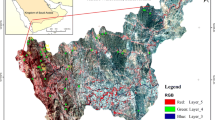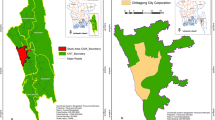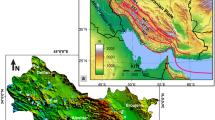Abstract
This paper describes the application of a well-known multi-criteria decision-making technique, called preference ranking organization method for enrichment evaluation (PROMETHEE II), in combination with fuzzy analytical hierarchy process (FAHP), as a weighting technique to explore landslide susceptibility mapping (LSM). To this end, eight landslide-related geodata layers of the Minoo Dasht located in the Gorgan province of Iran, involving slope, aspect, distance to river, drainage density, distance to fault, mean annual rainfall, distance to road and lithology have been integrated using the PROMETHEE II enhanced by FAHP technique. Afterward, the receiver operating characteristics (ROC) curves for the proposed LSM were drawn using an inventory of landslides containing 83 recent and historic landslide points, and the area under curve = 0.752 value was calculated accordingly. Additionally, to further verify the practicality of such susceptibility map, it was also evaluated against the landslide inventory using simple overlay. The outcome was that about 11 % of the occurred landslide points fall into the very high susceptibility class of the LSM, but approximately 52 % of them indeed fall into the high and very high susceptibility zones together. Also, it resulted that no recorded landslide occurred in the zone of very low susceptibility. According to the results of the ROC curves analysis and simple overlay evaluation, the produced map has exhibited good performance.








Similar content being viewed by others
References
Al-Shiekh Khalil W, Goonetilleke A, Kokot S, Carroll S (2004) Use of chemometrics methods and multicriteria decision-making for site selection for sustainable on-site sewage effluent disposal. J Anal Chim Acta 506(1):41–56
Ayalew L, Yamagishi H (2005) The application of GIS-based logistic regression for landslide susceptibility mapping in the Kakuda–Yahiko Mountains, Central Japan. Geomorphology 65(1/2):15–31
Behzadian M, Kazemzadeh RB, Albadvi A, Aghdasi M (2010) PROMETHEE: a comprehensive literature review on methodologies and applications. Eur J Oper Res 200(1):198–215
Brabb EE (1984) Innovative approaches to landslide hazard and risk mapping. In: Proceedings of the fourth international symposium on landslides, vol 1. Canadian Geotechnical Society, Toronto, Canada, pp 307–324
Brans JP (1982) Lingenierie de la decision. Elaboration dinstruments daide a la decision. Methode PROMETHEE. In: Nadeau R, Landry M (eds) Laide a la decision: nature, instruments et Perspectives Davenir. Presses de Universite Laval, Quebec, pp 183–214
Brans JP, Mareschal B (2005) PROMETHEE methods. Int Ser Oper Res Manag Sci 78(3):163–186
Brans JP, Vincke PH, Mareschal B (1986) How to select and how to rank projects: the PROMETHEE method. Eur J Oper Res 24:228–238
Caniani D, Pascale S, Sado F, Sole A (2008) Neural networks and landslide susceptibility: a case study of the urban area of Potenza. Nat Hazards 45:55–72
Carrara A (1983) A multivariate model for landslide hazard evaluation. Math Geol 15:403–426
Chang DY (1992) Extent analysis and synthetic decision. Optim Tech Appl 1:352
Cheng Z, Wang J (2007) Landslide hazard mapping using logistic regression model in Mackenzie Valley, Canada. Nat Hazards 42:75–89
Conoscenti C, Maggio CD, Rotigliano E (2007) GIS-analysis to assess landslide susceptibility in a fluvial basins of NW Sicily (Italy). Geomorphology 94:325–339
CRED (2010) Disaster data: a balanced perspective. CRED, Crunch, p 21
Dagdeviren M (2008) Decision making in equipment selection: an integrated approach with AHP and PROMETHEE. J Intell Manuf 19:397–406
Dai FC, Lee CF, Li J, Xu ZW (2001) Assessment of landslide susceptibility on the natural terrain of Lantau Island, Hong Kong. Environ Geol 43(3):381–391
Ercanoglu M, Gokceoglu C (2004) Use of fuzzy relations to produce landslide susceptibility map of a landslide prone area (West Black Sea Region, Turkey). Eng Geol 75(3–4):229–250
Fawcett T (2006) An introduction to ROC analysis. Pattern Recognit Lett 27:861–874
Feizizadeh B, Blaschke T (2011) Landslide risk assessment based on GIS multi-criteria evaluation: a case study in Bostan-Abad County, Iran. J Earth Sci Eng 1(1):66–71
Figueira J, Greco S, Ehrgott M (2005) Multiple criteria decision analysis state of the art surveys. Springer, Berlin, p 1045
Goumas M, Lygerou V (2000) An extension of the PROMETHEE method for decision making in fuzzy environment: ranking of alternative energy exploitation projects. Eur J Oper Res 123:606–613
Greco R, Sorriso-Valvo M, Catalano E (2007) Logistic regression analysis in the evaluation of mass movement susceptibility: the Aspromonte case study, Calabria, Italy. Eng Geol 89:47–66
Guzzetti F, Reichenbah P, Ardizzone F, Cardinali M, Galli M (2006) Estimating the quality of landslide susceptibility models. Geomorphology 81(1–2):166–184
Guzzetti F, Peruccacci S, Rossi M, Stark CP (2007) Rainfall thresholds for the initiation of landslides in central and southern Europe. Meteorol Atmos Phys 98:239–267
Hong Y, Hiura H, Shino K, Sassa K, Suemine A, Fukuoka H, Wang G (2005) The influence of intense rainfall on the activity of large-scale crystalline schist landslides in Shikoku Island, Japan. Landslides 2(2):97–105
Iovine G (2008) Mud-flow and lava-flow susceptibility and hazard mapping through numerical modelling, GIS techniques, historical and geo-environmental analyses. In: Proceedings of the iEMSs 4th biennial meeting, international congress on environmental modelling ANS software: integrating sciences and information technology for environmental assessment and decision making (iEMSs2008), vol 3, pp 1447–1460
Iovine G, Di Gregorio S, Lupiano V (2003) Debris-flow susceptibility assessment through cellular automata modelling: an example from 15–16 December 1999 disaster at Cervinara and San MAritno Valle Caudina (Campania, southern Italy). Nat Hazards Earth Syst Sci 3(5):457–468
Kahraman C, Cebeci U, Ulukan Z (2003) Multi-criteria supplier selection using fuzzy AHP. Logist Inf Manag 16(6):382–394
Kanungo DP, Arora MK, Sarkar S, Gupta RP (2006) A comparative study of conventional, ANN black box, fuzzy and combined neural and fuzzy weighting procedures for landslide susceptibility zonation in Darjeeling Himalayas. Eng Geol 85:347–366
Kayastha P, Dhital M, De Smedt F (2012) Landslide susceptibility mapping using the weight of evidence method in the Tinau watershed, Nepal. Nat Hazards 63(2):479–498
Komac M (2006) A landslide susceptibility model using the analytical hierarchy process method and multivariate statistics in perialpine Slovenia. Geomorphology 74(1–4):17–28
Lee S, Evangelista DG (2006) Earthquake-induced landslide-susceptibility mapping using an artificial neural network. Nat Hazards Earth Syst Sci 6:687–695
Lee S, Min K (2001) Statistical analysis of landslide susceptibility at Yongin, Korea. Environ Geol 40:1095–1113
Lee S, Choi J, Min K (2004) Probabilistic landslide hazard mapping using GIS and remote sensing data at Boun, Korea. Int J Remote Sens 25(11):2037–2052
Macharis C, Springael J, Brucker KD, Verbeke A (2004) PROMETHEE and AHP: the design of operational synergies in multicriteria analysis. Strengthening PROMETHEE with ideas of AHP. Eur J Oper Res 153:307–317
Mahmoodzadeh S, Shahradi J, Pariazar M, Zaeri MS (2007) Project selection by using fuzzy AHP and TOPSIS technique. Int J Hum Soc Sci 1(3):135–140
MNR (Ministry of Natural Resources) (2010) Khuzestan Province landslide event report, Khuzestan, Iran
Moradi M, Bazyar MH, Mohammadi Z (2012) GIS-based landslide susceptibility mapping by AHP method, a case study, Dena City, Iran. J Basic Appl Sci Res 2(7):6715–6723
Nandi A, Shakoor A (2009) A GIS-based landslide susceptibility evaluation using bivariate and multivariate statistical analyses. Eng Geol 110(1–2):11–20
Nielsen TH, Wrigth RH, Vlasic TC, Spangle WE (1979) Relative slope stability and land-use planning in the San Francisco Bay region, California. US geological survey professional paper 944
Ozdemir A (2011) Landslide susceptibility mapping using Bayesian approach in the Sultan Mountains (Akşehir, Turkey). Nat Hazards 59(3):1573–1607
Perriello Zampelli S (2009) Evaluation of sliding susceptibility in volcaniclastic soils of Campania (Southern Italy) aided by GIS techniques. Geografia Fisica e Dinamica Quaternaria 32(2):227–236
Perriello Zampelli S, Bellucci Sessa E, Cavallaro M (2012) Application of a GIS-aided method for the assessment of volcaniclastic soil sliding susceptibility to sample areas of Campania (Southern Italy). Nat Hazards 61(1):155–168
Ruff M, Czurda K (2008) Landslide susceptibility analysis with a heuristic approach in the Eastern Alps (Vorarlberg, Austria). Geomorphology 94:314–324
Thiery Y, Malet JP, Sterlacchini S, Puissant A, Maquaire O (2007) Landslide susceptibility assessment by bivariate methods at large scales: application to a complex mountainous environment. Geomorphology 92(1–2):38–59
Vincke JP, Brans P (1985) A preference ranking organization method. The PROMETHEE method for MCDM. Manag Sci 31:641–656
Vos F, Rodriguez J, Below R, Guha-Sapir D (2010) Annual disaster statistical review 2009: the numbers and trends. Centre for Research on the Epidemiology of Disasters (CRED), Université catholique de Louvain, Brussels
Yalçın A (2008) GIS-based landslide susceptibility mapping using analytical hierarchy process and bivariate statistics in Ardesen (Turkey): comparisons of results and confirmations. Catena 72(1):1–12
Zadeh L (1965) Fuzzy sets. Inf Control 8:338–353
Author information
Authors and Affiliations
Corresponding author
Rights and permissions
About this article
Cite this article
Roodposhti, M.S., Rahimi, S. & Beglou, M.J. PROMETHEE II and fuzzy AHP: an enhanced GIS-based landslide susceptibility mapping. Nat Hazards 73, 77–95 (2014). https://doi.org/10.1007/s11069-012-0523-8
Received:
Accepted:
Published:
Issue Date:
DOI: https://doi.org/10.1007/s11069-012-0523-8




